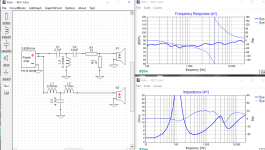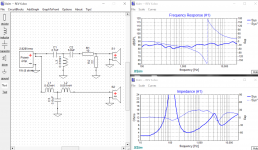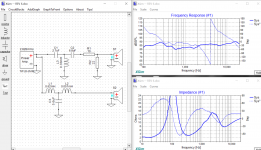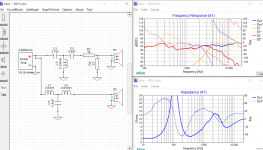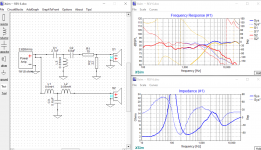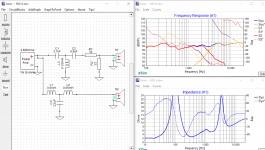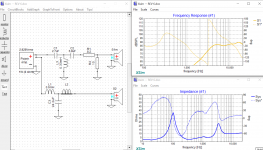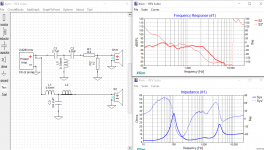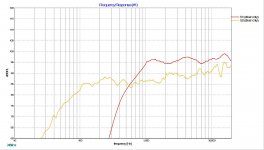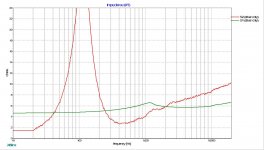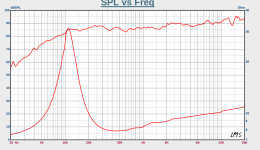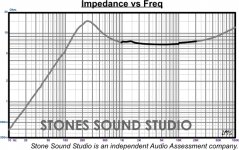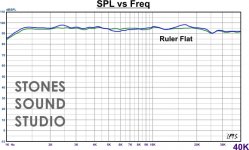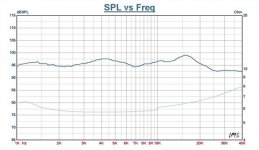I read that even order crossover that has good phasing will have a deep null when the polarity is reversed. Will this apply to odd order crossover? I have tried to sim a crossover for my project and when I reverse the polarity, instead of having a deep null, it rises up.
Also, in XSim, what is the difference between as derived and as measured? Which one should I use if I got the drivers data from tracing the manufacturer specs?
I attached the files that I use for my project. The .dxo is also in that file, maybe if someone want to help me to design a crossover? Thanks!
Also, in XSim, what is the difference between as derived and as measured? Which one should I use if I got the drivers data from tracing the manufacturer specs?
I attached the files that I use for my project. The .dxo is also in that file, maybe if someone want to help me to design a crossover? Thanks!
Attachments
The response that matters is the acoustic one. Not the electrical one.
In otherwords, you could have a 2nd order network - hitting 3rd order slopes and thus 270/90 degrees out of phase
Another example - you could have a 3rd order network - hitting 4th order slopes and thus 0 degrees in phase. Reversing here should produce a null.
First order acoustic crossovers are very rare and often require more components than all the other topologies to gently "shape" the response via many notch filters.
All this boils down to - forget the on paper order and focus on the target acoustic slopes you are aiming for. trying to minimise # of components to get there
Did you measure the driver responses yourself? Did you include measured phase?
If not - then you need to add a Z offset on the woofer to account for the arrival time difference and thus altering phase / summation.
For a simple 2 way on a flat baffle, asymmetric slopes are often needed to achieve an inphase acoustic response at the Fc (crossover point) and either side. Usually achieved by steeper tweeter slope and / or relaxed woofer slope. Adding a series resistor to the 2nd order (parallel) component can be used to shape the slope.
In otherwords, you could have a 2nd order network - hitting 3rd order slopes and thus 270/90 degrees out of phase
Another example - you could have a 3rd order network - hitting 4th order slopes and thus 0 degrees in phase. Reversing here should produce a null.
First order acoustic crossovers are very rare and often require more components than all the other topologies to gently "shape" the response via many notch filters.
All this boils down to - forget the on paper order and focus on the target acoustic slopes you are aiming for. trying to minimise # of components to get there
Did you measure the driver responses yourself? Did you include measured phase?
If not - then you need to add a Z offset on the woofer to account for the arrival time difference and thus altering phase / summation.
For a simple 2 way on a flat baffle, asymmetric slopes are often needed to achieve an inphase acoustic response at the Fc (crossover point) and either side. Usually achieved by steeper tweeter slope and / or relaxed woofer slope. Adding a series resistor to the 2nd order (parallel) component can be used to shape the slope.
Last edited:
That's the problem. I don't have the resources to measure my drivers since buying a microphone for measuring is so expensive in my country. So, I just keep in mind that it will not be the maximum that I can get out of my drivers.
What's your feedback towards my design that I have attached above?
What's your feedback towards my design that I have attached above?
That's the problem. I don't have the resources to measure my drivers since buying a microphone for measuring is so expensive in my country. So, I just keep in mind that it will not be the maximum that I can get out of my drivers.
What's your feedback towards my design that I have attached above?
What drivers are you using?
Post individual response curves for drivers with their xo circuits applied - including phase response
Your treble / tweeter level is too high
I don't think you have any bafflestep compensation = no / weak bass
the 0.1mh / 0.05mH inductor is useless - remove it
I am using the as derived option on XSim. Is it close to accurate? I know to get the most accurate result is to measure.
Below I attached the pictures in my XSim using the as derived option. Notice I included 2 design, one which uses 5.6uf in parallel to the woofer and one uses 22uf in parallel to the woofer.
The 5.6uf increased the db above the crossover point while inverted and the 22uf has a null on the crossover point when inverted. How will this affect the final product? Which one is better? Thanks!
Below I attached the pictures in my XSim using the as derived option. Notice I included 2 design, one which uses 5.6uf in parallel to the woofer and one uses 22uf in parallel to the woofer.
The 5.6uf increased the db above the crossover point while inverted and the 22uf has a null on the crossover point when inverted. How will this affect the final product? Which one is better? Thanks!
Attachments
In addition to my questions - what Z offset have you entered? (I am unsure how XSim allows for that for derived phase)
incredible80, it's an accurate way of calculating phase, but it doesn't consider the phase of your baffle, or driver distances. Ideally both of these need to be added after, meaning you should be bringing your own phase.
However, the way you are doing it, plus delay, plus a baffle estimate, will be good enough for now.
However, the way you are doing it, plus delay, plus a baffle estimate, will be good enough for now.
The tweeter will be flush mounted while the woofer will not. I don't know if mod delay in XSim is the same as z axis or not, but I entered 0.15inches in the mod delay
The baffle will be 15cm wide which gives a BSC of approx 720hz, I don't think I will be needing too much BSC since I will be only using it in my bedroom near the wall with a tv in the middle.
Below I attach the response of both the tweeter and the woofer
The baffle will be 15cm wide which gives a BSC of approx 720hz, I don't think I will be needing too much BSC since I will be only using it in my bedroom near the wall with a tv in the middle.
Below I attach the response of both the tweeter and the woofer
Attachments
Last edited:
What drivers are you using?
Impedance looks a little low. Hard to see at that scale / resolution. Does it dip below 3ohms? the bass impedance is worrying but could just be an anomaly with the source data. What amplification will be using?
Impedance looks a little low. Hard to see at that scale / resolution. Does it dip below 3ohms? the bass impedance is worrying but could just be an anomaly with the source data. What amplification will be using?
I don't think you have any bafflestep compensation = no / weak bass
Without knowing baffle dimensions that's just a guess.
Correct me if I'm wrong, the impedances seem lower than they should be.
At first I thought the woofer was strange going that high but now I see it is a full range. Keep in mind that is an on-axis plot when you cross.
At first I thought the woofer was strange going that high but now I see it is a full range. Keep in mind that is an on-axis plot when you cross.
Attachments
I think the woofer zma is low as well. What about your tweeter response, the manufacturer plot looks more smooth.
I found the .zma and .frd files for the tweeter (Fountek Neo CD3.0) from Driver FRD & ZMA files. I think he measured this driver.
Attachments
I don't see the point in crossing a 3" fullrange to a tweeter, what the 3" is missing is the bass not the highs. Moreover the choice for the tweeter is surprising, at least to me: here one of these tweeters will cost like a calibrated usb mic, I would rather spend the money on a mic and have still money left for a couple of inexpensive tweeters (for example ND20FA/B), if there is the urge to use a tweeter.
Have a good read here: Zaph|Audio
IMHO you need to understand what the baffle step effect is. You can't simply trace the mfg FR and use that in XSim, unless you are building an in-wall speaker.
Ralf
Have a good read here: Zaph|Audio
IMHO you need to understand what the baffle step effect is. You can't simply trace the mfg FR and use that in XSim, unless you are building an in-wall speaker.
Ralf
- Home
- Loudspeakers
- Multi-Way
- 3rd Order Crossover Reverse Null
